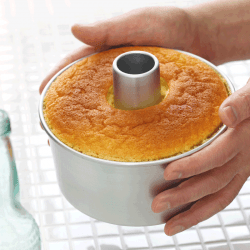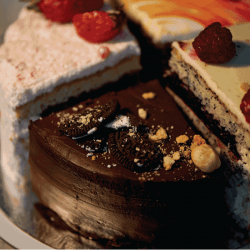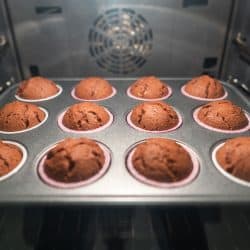Silicone bakeware has become very popular in recent years for many reasons. One of the main reasons is because food doesn't easily stick to it. So, you may now be wondering if you still need to grease it before use. We've done some digging and found quite a bit of information on the topic.
Silicone naturally has non-stick properties, so it is not always necessary to grease it when using it. However, while not required, greasing is another barrier to prevent sticking, especially with larger molds and cake pans. Greasing also makes clean-up easier.
Please keep reading to find out more information about silicone molds and cake pans and their proper use. If you aren't familiar with silicone baking products, you will also discover some basics to give you peace of mind while using them in the kitchen.
![]()
Tips and Tricks with Silicone in the Kitchen
While silicone is known for being non-stick, there are tips and tricks to make cooking easier. No product is 100% non-stick, but there are things you can do to make sure your silicone baking pans and molds perform as well as possible.
How do you keep a cake from sticking to a silicone mold?
Silicone molds are great for many baking projects but not perfect. One tip to help prevent sticking is to remember that the larger the mold, the greater the chances of your items sticking. Smaller is better.
Therefore, large baked goods might do better in a metal or glass rather than silicone. There is more stability with the traditional type pans, so your cake is less likely to crack.
However, if you decide to use silicone, a basic shape will be easier to unmold than a novelty shape—the more details in the mold, the more opportunity for the batter to stick. If you are using a novelty shape, be sure to grease it.
How do you unmold a cake from a silicone mold?
![]()
Baking molds can be tricky no matter the material, but silicone has some advantages. The non-stick properties and flexibility make it much easier to unmold baked goods easily.
Once your confection is completely cooled, pull and gently stretch the edges of the pan away from the baked good to loosen it from the mold. Then, use your fingers to invert the mold popping out the baked good.
To see it in action, watch this ">YouTube video:
Do you need to grease and flour silicone bakeware?
One of the advantages of silicone bakeware and its popularity is that food doesn't stick easily. If your silicone pieces are small, you should be fine without greasing the molds unless you choose to do so for easier clean-up.
However, with larger molds like a cake, it is highly recommended that you grease and flour the mold or spray with non-stick cooking spray to help prevent sticking.
How do you grease silicone cake molds?
You would grease a silicone cake mold just like a regular mold. For smaller pans and molds, cooking sprays are sufficient. For others, rub it with oil, butter, or a solid cooking fat like Crisco.
Some people even like to coat with flour after greasing. The flour provides another barrier layer between the cooking mold and the batter to help prevent sticking so that you can easily separate your baking from the mold.
One tip is to replace the flour with cocoa powder in chocolate cakes for added flavor. For an upgraded baking experience, consider Valrhona, a high-quality 100% dutch processed cocoa powder.
Why Silicone Bakeware?
![]()
Advantages
There are many reasons silicone bakeware products have become a favorite in the home kitchen. The benefits are numerous! Have a look below.
Nonstick
Did we mention that food doesn't stick? You don't need cooking sprays or fats which can add calories. Not to mention prep time is lessened. Foods slide out quickly, reducing worry over damaged baked goods.
Stain Resistant
Silicone is stain resistant which is a definite plus, especially when working with food coloring. Your bakeware will continue to look good use after use. You also don't have to worry about rust like with some metal pans—another bonus.
Easy to Clean
Because food doesn't easily stick, clean-up is a breeze. You can throw it in the dishwasher or soak it for a few minutes in warm, soapy water.
Withstands extreme temperature changes
Silicone is excellent for the oven or the freezer. It can withstand sudden and extreme temperature changes without damage. It also cools very quickly once out of the oven. Each manufacturer recommends temperature limits that your should follow to protect your silicone bakeware from damage.
Flexible
The flexible shape makes unmolding cakes and baked goods so much easier. The sides easily dislodge from what you are baking, letting the food easily slide out.
The second benefit of the bendable structure is storing and stacking in your cabinets --so much more convenient than traditional pans. You can bend and fold your pans and molds without worrying about them losing their original shape.
One word of caution, the lack of structure can cause batter spills. Sometimes, it is best to place your silicone pieces on a baking sheet for more manageable transport to and from the oven.
Budget-friendly
Silicone is very affordable and can be used repeatedly, so with proper care, you will have your pieces for a long time. At such a budget-friendly price point, it's not a financial burden to own several pieces.
However, be aware of super-cheap items that might not be 100% pure silicone. Stay away from those. They have fillers and won't perform as well.
Variety
Silicone bakeware isn't dull. It comes in a variety of colors and shapes to make baking fun. All you need is your creativity and a few ingredients. Then, you can use your silicone cake pans and molds to make exciting treats for all your events.
Versatility
Silicone bakeware isn't just for baking. There are many options for using your silicone pieces. For example, smaller bakeware pieces like individual muffin cups or cupcake molds can double as serving dishes. Not to mention they are perfect for holding snacks.
Next, the small novelty baking molds are great for freezing ice cubes or other cold treats. They even work well for candy-making and fondant molding.
If you haven't tried silicone bakeware yet, you definitely should. You can often find variety sets that bundle everything you need to get started at a reasonable cost.
Consider this top-rated 31 piece set.
Silicone 101
Quality
There are a lot of silicone kitchen products on the market. So many that it can be overwhelming with all the options and price points available. When purchasing silicone kitchen products, especially bakeware, make sure you buy 100% pure silicone and not an inferior product mixed with fillers. Anything less than 100% will not yield the baking results for which silicone is known.
So, how do you know if silicone is 100% pure if it isn't marked? There is a simple test to make sure a silicon product is pure.
Pinch and twist the silicone, and if the color stays consistent without white or lighter stress marks, then the silicone is pure. Added fillers dilute and compromise the consistency of silicone which results in a lighter color when stressed. Fillers can also emit odors when baking.
Safety
Decades of research don't show any indications or evidence that silicone is harmful for use in cooking. Silicone is a synthetic rubber made from naturally occurring silicon and oxygen. However, there are always those that voice concern over the use of synthetic products.
Here is what we know about silicone safety:
- Food-grade silicone is FDA-approved as a food-safe substance.
- It is approved to be used at temperatures up to 500 degrees Fahrenheit, depending on the manufacturer.
- Silicone is non-reactive and does not leech into food.
- Silicone can melt at extremely high temperatures but does not emit toxic gases.
Care
There are some simple tricks to give your silicone the best care. Silicone is safe for use in the oven, microwave, freezer, and dishwasher. It is easy to clean, so avoid using anything abrasive that might damage it.
Here are a few issues you may notice about your silicone over time. No worries; it's all normal and easy to remedy.
First, if your silicone has a greasy residue, even after being washed, wiping it out with a clean cloth should fix it. If that doesn't work, sprinkle it with baking soda and let it sit for a while.
Another issue might be finding a white build-up of calcium sulfate on your silicone pieces if you have hard water. Remove it by soaking it in water and vinegar.
Happy Baking!
Silicone bakeware is a great tool to have in your kitchen, and there are many options available. It's an excellent replacement for your old molds and cake pans, but you might want to keep at least one traditional cake pan for larger projects.
To find out more about silicone kitchen products, check out "Are Silicone Oven Mitts Better?"
Also, consider "What Is Better: Nylon Or Silicone Utensils?"






![fresh and homemade prepared batter for brownies with nuts served on a baking tray on rustic and wooden table - How Many Cake Mixes For A Half Sheet Cake? [And Full Sheet Too!]](https://kitchenseer.com/wp-content/uploads/2022/03/fresh-and-homemade-prepared-batter-for-brownies-with-nuts-served-on-a-baking-tray-on-rustic-and-wooden-table-250x250.jpg)
